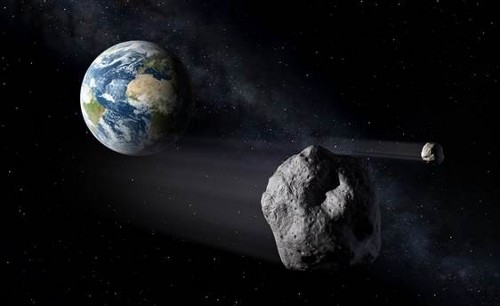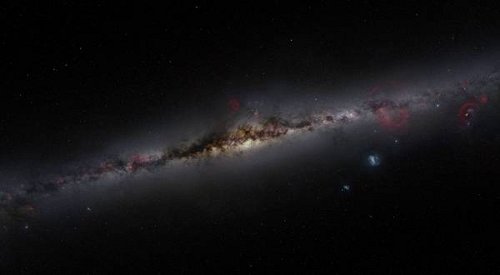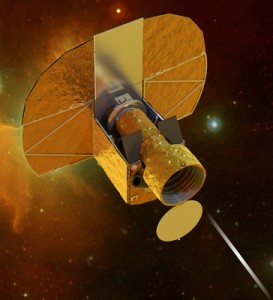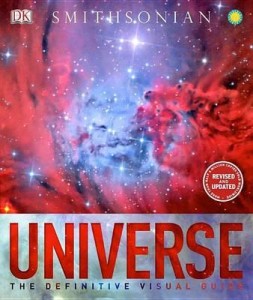Centauri Dreams
Imagining and Planning Interstellar Exploration
Swansong Earth: Refuges for Life
As we begin to identify planets in the habitable zone of their stars, the larger issue becomes what fraction of stars have such planets. This is eta-Earth (?Earth), the percentage of Sun-like stars with Earth-like planets in the habitable zone, a figure we can gradually home in on as statistical surveys like Kepler continue to churn. Right now the estimate depends on whom you talk to, with figures ranging from 1.4-2.7% (Catanzarite & Shao, 2011) to 42% for red dwarf stars (Bonfils et al., 2011). One thing I haven’t seen discussed much is the question of when planets cease being habitable, including what we can call the phases of habitability on a given world.
Jack T. O’Malley-James (University of St Andrews, UK) and colleagues have gone to work on the question in a new paper slated for publication in the International Journal of Astrobiology. The researchers note that life emerged on Earth 3.8 billion years ago and perhaps somewhat earlier. The key point is that unicellular organisms were found on our planet at least 2.5 billion years before fossil evidence of multicellular life appears. And most animal phyla do not appear as body fossils until 530 million years ago, during the period known as the ‘Cambrian explosion.’

We’re living in an era that obviously supports complex life, but the continuing evolution of the Sun will take us past that state, with microbes again being the only forms of life likely to survive in the far future. We can see that extremophiles can survive today in conditions that would be extreme to impossible for humans, existing at high temperatures, highly acidic waters and other improbable places. O’Malley-James and company argue that it is statistically likely that the habitable Earth-like planets we find will be at a stage supporting unicellular rather than multicellular life.
That means we need to understand the biosignatures such worlds might exhibit, which could be unlike those produced by the majority of life on Earth today. We don’t want to miss a planet with a living microbial biosphere because its detected biosignatures differ so widely from our own. What we will eventually need are simulations of these microbial environments under different levels of radiation and surface conditions to consider what biosignatures will be detectable, using host planets that range from Earth itself to planets around red dwarfs and in binary star systems. This paper begins that process by looking at the Earth’s next three billion years.
The factors influencing habitability include solar luminosity, greenhouse gases, orbital characteristics, hydrogen escape and the runaway greenhouse effect. Looking at the Earth, the researchers find a sharp increase in surface temperatures starting about one billion years from now, keyed to the onset of rapid ocean evaporation. In high latitude regions, unicellular life might persist for up to 2.8 billion years from the present. By assuming an upper temperature boundary of 420 K (this is an extension of today’s thermophile tolerances), they also find that life could persist about 700 million years longer at the poles than at the equator, a location that could change depending on future changes in the Earth’s axial tilt or the eccentricity of its orbit.
It’s a fascinating world even if shorn of complex life, one in which pockets of living things hold out:
Rapid ocean loss as a result of a moist greenhouse effect would likely represent the end-point of a planet’s habitable lifetime. Assuming ocean loss was not uniform across the globe due to regional temperature variations, there could potentially be pockets of liquid water that remain for a brief time before total loss of liquid surface water occurs. A source of liquid water is a prerequisite for life as we know it; hence, these last pools of water would represent the final habitable regions on a dying planet.
The locations of these last habitable regions? Ocean floor trenches for one (the Marianas Trench extends about 11 kilometers below sea level). High altitude lakes are another possibility, and there is the distinct possibility that far-future life might retreat into cave systems. We’re learning more all the time about how many microbial communities exist without solar energy, and caves with their greatest volume below their entrance could act as cold reservoirs. Moreover, a far-future Earth might be one with a greater axial tilt as the Moon recedes and Earth’s rotation slows. At this point, with obliquity values of 30 to 60 degrees, equatorial regions may be more accommodating to life than the formerly cooler polar areas.
The last pools of water on Earth will likely be warm, isolated and highly saline, which means Earth’s last lifeforms will be able to tolerate high concentrations of salt and high temperatures. The researchers think such life will be found in microbial mat communities that resemble some of the life forms we’ve found around hydrothermal vents. The low abundance of ozone in this future era will subject these organisms to elevated levels of UV radiation. We can find some analogs to this in microbiological communities in some of the highest volcanoes of Chile’s Atacama desert, which live under arid conditions with large daily temperature variations.
The biosignatures of Earth will evolve until the point at which the planet is completely uninhabitable. Until that point, the by-products of an extremophile biosphere may be tricky to find:
The microorganisms from the Atacaman volcanoes appear to use the oxidation of carbon monoxide to obtain energy…While the slowing of plate tectonics may decrease the amount of available CO, hotspot volcanoes (those caused by upwellings from the deep mantle rather than at plate boundaries) could still exist. Mars (which is not tectonically active) exhibited this kind of volcanism up to as early as 2 Myr ago…, while hotspot volcanism may still be actively ongoing on Venus…The thermohalophilic organisms listed above are all anaerobic organisms which produce hydrogen, carbon dioxide, ethanol and acetate as by-products of their metabolic processes. Acetates are not promising as remotely detectable biosignatures, only managing to escape into the atmosphere (at a very slow rate) if they are formed within very acidic (pH < 4.7) water...
One possibility is that on a planet with low carbon dioxide levels compared to today’s Earth, the biological production of CO2 would produce the kind of disequilibrium that flags the presence of life. Even so, assuming a global distribution of geothermal pools equal in size to the largest ones found on Earth today, and assuming a similar number of ice caves and active hydrothermal vents as well as a basaltic crust inhabited by microbes, the authors come up with a global biological productivity that is two orders of magnitude lower than what was found on Earth before photosynthesis occurred.
Can such a reduced biosphere produce biosignatures strong enough to be detected over interstellar distances? The question is unresolved and awaits further work on biosignatures in specific extremophile environments. What’s significant about this early analysis is that it suggests the average terrestrial world around a G-class star will most likely be populated not with complex lifeforms but microbes, based on the past and future course of life on our own planet. We’re also left to ponder the need of intelligent species to use their time wisely, aware of the window for complex life and taking steps to ensure their survival once their planet becomes uninhabitable.
The paper is O’Malley-James et al., “Swansong Biospheres: Refuges for life and novel microbial biospheres on terrestrial planets near the end of their habitable lifetimes,” accepted for publication in the International Journal of Astrobiology (preprint). Thanks to Tatiana Covington for the pointer on this one.

Asteroid Deflection: The Paintball Solution
Planetary Resources has us thinking about mining the asteroids to extract useful materials, but learning more about these objects will benefit us in all kinds of ways. Not only do asteroids offer up clues about the early Solar System, but getting to understand their composition and structure will be a key element in any future plans to change an asteroid trajectory. The topic comes to mind periodically as various asteroids make close approaches, and right now I’m looking at asteroid 2012 DA14, which will close to within 22,000 kilometers this coming February.
2012 DA14 is a small asteroid, discovered in early 2012 at the Observatorio Astronómico de La Sagra in Spain, and it is not an impact threat for us next year, although prudence dictates keeping an eye on it for future orbits — the object is recently enough discovered that we’ll need to study it longer to get a better read on future encounters. I see that the University of Central Florida is organizing a viewing party in Orlando on February 15 to track the progress of the asteroid as it zips past us, with Michael A’Hearn, who led the Deep Impact mission, and Harold Reitsema (B612 Foundation) on hand to discuss asteroid research and tracking projects.
Meanwhile, an interesting story comes out of MIT involving a graduate student in the Department of Aeronautics and Astronautics there named Sung Wook Paek, author of a new paper on asteroid deflection. Paek’s notion is that pellets of paint powder launched from a spacecraft close to a problematic asteroid could be used to greatly increase its albedo. The now more reflective asteroid would be nudged off-course slowly but surely by solar photons. All of this would depend on getting to the asteroid long enough in advance to let the method work.
Paek’s work grew out of a call for papers from the United Nations’ Space Generation Advisory Council, whose technical paper competition Paek was able to win, a feat that took him to Naples to present the paper at the International Astronautical Congress in October. The competition was all about new ways of deflecting an asteroid, many of which involved launching a projectile to collide with the object, or setting off a nuclear device near enough to it to disrupt its orbit. We’ve also discussed methods like ‘gravity tractors’ in these pages, where the tiny effects of a spacecraft’s gravitational field work, over time, to draw the asteroid into a new orbit.

Image: The more methods for asteroid deflection we examine, the larger our toolkit in case we ever do find one on a dangerous course. Credit: GETTY.
In Paek’s method, the paint pellets would contribute their own impact to help bump the asteroid slightly off course, while the paint itself would eventually take advantage of solar photon pressure. Using the asteroid Apophis as his model, Paek calculated that five tons of paint would cover the surface (Apophis is about 450 meters in diameter) in a five-micrometer thick layer. Total time to move the asteroid out of an Earth-bound trajectory: 20 years, highlighting the need to get to such objects as soon as possible. Lindley Johnson, program manager for NASA’s Near Earth Objects Observation Program, calls Paek’s proposal an innovative variation on various methods to use solar radiation pressure. In any case, having a wide range of deflection options is only prudent in the event we ever do discover an asteroid on a truly threatening trajectory.

Opening Minds to the Stars
When it comes to experiencing the night sky, there are times when mathematics fades away and poetry comes to the fore. Witness these lines from John Milton’s Paradise Lost:
A broad and ample road, whose dust is gold,
And pavement stars, as stars to thee appear
Seen in the galaxy, that milky way
Which nightly as a circling zone thou seest
Powder’d with stars.
The lines bring back a crisp fall night in the Adirondacks when my wife, my daughter and I were crossing Lake George in a small boat. I’ve seen the Milky Way from many places but never has it seemed so striking as that night, perfectly framed by the surrounding hills, and Milton’s word ‘powder’d’ has the scene exactly right, for the stars seemed like a fine dust interspersed with jewels. The closest photo I’ve seen that captures a scene like this is a spectacular image taken over the snowy cliffs of Creux du Van near Neuchâtel, Switzerland that I found in a new book from the Smithsonian called Universe: The Definitive Visual Guide.
Every year as we start to get into holiday season I look around for a volume something like this. The challenge faced by those of us who try to communicate something of the scale of the universe — the distances between stars and galaxies themselves — is that students don’t leave high school and even college with a real sense of what makes the interstellar void so difficult to cross. Sometimes a well-placed brick of a book laced not only with the best astrophotography but succinct explanations of astronomical phenomena can light a fire in a young mind and awaken awe in the cosmos. Paging through it can also be a useful restorative to anyone’s whose sense of wonder has become jaded.
Martin Rees (University of Cambridge), former president of the Royal Society and now Astronomer Royal, is general editor for this 528 page coffee-table volume, working with a carefully chosen team of writers and astronomers that includes Iain Nicolson, whose 1978 book The Road to the Stars put many of the evolving concepts of interstellar flight in front of the public. Universe works through the basic concepts of astronomy and then moves into a grand tour that encompasses local stars, the Orion Arm and fans out into the galaxy, with an attention to scale that should take the breath of attentive newcomers away when galaxy after galaxy swings into view and the subject turns to clusters of galaxies and their astounding architecture.
Leave this massive but inviting book open in your living room and watch people page through it. The box-like explanations are succinct, just enough to get someone up to speed on red and blue shift, for example, to make sense of Hubble’s findings. The treatment of special and general relativity is compressed into six highly illustrated pages that get across the basic concepts non-mathematically. The text throughout is beautifully supported with diagrams and photography, visual flashcards that invite you to brush up on your facts here and there depending on where you happen to open the book. Thus this about distance considered in terms of the speed of light:
The expansion of space complicates the expression of distances to very remote objects, particularly those that we now observe as they existed more than 5 billion years ago. When astronomers describe the distance to such faraway objects, by convention they use the ‘lookback’ or ‘light-travel-time’ distance. This is the distance that light from the object has travelled through space to reach us today, and it tells us how long ago the light left the object. But because space has expanded in the interim, the distance of the galaxy when the light began its journey towards Earth is less than the lookback distance. Conversely, the true distance to the remote object (called the ‘comoving’ distance) is greater than the lookback distance. These distinctions need to be remembered when, for example, a galaxy is stated as being 10 billion light-years away.
I mention that one in particular because it’s admirably concise and supported with useful artwork on the over-sized pages of this volume, as are so many concepts people acquainted with the field begin to think of as routine but which laymen, coming to them for the first time, can find confusing. Thus current thinking on the Big Bang is beautifully illustrated in ways that give a visual sense for cosmic inflation, the separation of forces, the emergence of matter and the ignition of the first stars. For those with a telescope, a large section on the constellations and a series of sky charts help relate the astrophysical objects under discussion to their place in the night sky.
When I was growing up, the best photography of the heavens was available mostly in black and white images from places like the Palomar Observatory, then working without benefit of adaptive optics. The space-based telescopes whose work graces these pages were obviously not available then. I still have many books from the time and remember how those images thrilled me. Today, a glance at a double-page spread of the ‘Pillars of Creation’ in the Eagle Nebula or the almost surreal beauty of the globular cluster M9 as seen from space could easily turn a young person with a science fictional bent — or perhaps a poet — toward a career actively pursuing deep space topics. This lovely volume should wind up as a carefully placed holiday gift, assuming that you, as do I, have a particular relative or friend whose eyes are begging to be opened to the stars.

SETI: Rummaging in the Data
Astronomy is moving at a clip that sees more data accumulated than can possibly be examined at the time they’re collected. We’re creating vast storehouses of information that can be approached from various angles of study. Now ponder how we might use these data for purposes beyond what they were collected for. In a new paper submitted to the Astronomical Journal, Ermanno Borra (Université Laval, Québec) looks at how standard astronomical spectra — including those already taken — can be used as part of SETI, the Search for Extraterrestrial Intelligence.
Here’s the idea: Suppose somewhere out there a civilization decides to reveal its existence to the rest of the galaxy. These extraterrestrials reason from their own experience of science that an advanced civilization will study the sky and take spectra of astronomical objects. These spectra become the medium upon which the senders impose their signal. At our end, spectroscopic surveys of vast numbers of stars allow us to accumulate data that may contain evidence of an unusual signal, a spectrum deliberately crafted to be so striking that it calls attention to itself.
How to create the signal? Through modulating the spectrum by sending short bursts of laser light, an idea Borra addressed in a 2010 paper, as discussed again in this one:
Borra (2010) shows that periodic time variations of the intensity signal originating from a pulsating source modulate its frequency spectrum with periodic structures. Periodic time variations of the intensity signal originating from a pulsating source with periods between 10-10 and 10-15 seconds would modulate its spectrum with periodic structures detectable in standard astronomical spectra. Periods shorter than 10-10 seconds could be detected in high-resolution spectra. Note that the modulation is rigorously periodic in the frequency units spectrum but not in the wavelength units spectrum.

Image: A panoramic image of the Milky Way. Could we use spectroscopic data from surveys already conducted to find evidence of other civilizations? Credit: Photopic Sky Survey.
You can see the beauty of this proposition. We already have mountains of spectroscopic data acquired for other studies, data that can be analyzed visually or through Fourier transform software. Borra wants to make astronomers aware of this potential use for such data as a complement to existing optical SETI work carried out at sites like the Wyeth Telescope (Harvard/Smithsonian Oak Ridge Observatory) and the SERENDIP instrument at UC-Berkeley. The latter are cutting-edge projects, but with some limitations, the biggest being that they can observe only one object at a time. They also require either dedicated instruments or telescope time on standard telescopes, a limitation that a database hunt of earlier work surmounts.
Borra finds that the energy needed to generate the needed signals is feasible even for a civilization like ours — he analyzes it in terms of current equipment by referencing diode-pumped laser technology similar to the Helios laser designed at Lawrence Livermore National Laboratory for inertial confinement fusion studies. The result: An isolated signal transmitted at 1000 light years (a sphere within which there are roughly a million stars) would be detectable with today’s instruments. A spectroscopic survey like the Sloan Digital Sky Survey could find it.
By ‘isolated’ signal, Borra means a signal sent from a place distant enough from the home star so that the signal would not be directly superimposed on the spectrum of the star itself. The other case is a signal sent from the home planet, one that would therefore mix with the stellar spectrum. Now the signal becomes harder to detect because it is considerably weaker than the total energy of the stellar spectrum, requiring the extraterrestrial senders to resort to more powerful sources. Here Borra references the 2004 paper from which he drew the Helios comparisons:
… we can assume that, considering the Moore’s law of laser technology, a more advanced civilization should have no trouble increasing the laser power by 2 to 3 orders magnitude making the signal readily detectable. For a solar-type star at 1000 ly the signal would then be comparable to the stellar background and thus easily detectable… The Moore law suggestion is intuitively justified by simply imagining how Howard et al. (2004) and the present article would have been received before the invention of the laser 60 years ago, when the signal would have had to be generated with light bulbs!
A Kardashev Type I civilization should be able to manage the power output to make its superimposed signal observable at nearby stars, but a Type II would be capable of harnessing all the energies available from its home star, making the production of such signals feasible for vast numbers of potential recipients. Because, as Jill Tarter has often commented, civilizations trying to contact us are likely to be more advanced technologically than we are, the possibility of finding such Type II civilization signals in astronomical spectra becomes an intriguing issue.
What’s appealing about Borra’s approach is its sheer simplicity. The database-mining idea for SETI has a history in the literature going back to papers in 1977 (Zbigniew Paprotny) and 1980 (Daniel Whitmire and David Wright), who suggested searching for anomalous spectral lines originating from radioactive fissile waste material. Geoff Marcy and Amy Reines have carried out a search of 577 nearby stars looking for emission lines too narrow to be natural. Signal-finding algorithms incorporated into existing software can be used with present and future spectroscopic data to continue this hunt, all achieved, as Borra says, with a few lines of code.
Is a SETI signal to be found in our databases? The paper is Borra, “Searching for extraterrestrial intelligence signals in astronomical spectra, including existing data,” accepted for publication by the Astronomical Journal (preprint). Thanks to Antonio Tavani for first calling this one to my attention, and several other readers who also sent in the link.

Wanderers Between the Galaxies
The idea of planets outside their normal settings is unsettling. It implies that beyond the stars all around us there may be worlds without suns, dark planets presumably pushed there by gravitational instabilities in their home systems. We’ve looked at such ‘nomad’ worlds before, noting that ice overlaying a frozen ocean might trap enough geothermal heat to create life-sustaining conditions. Estimates on how many such planets might exist vary widely, but in one recent paper Louis Strigari (Stanford University) has calculated that 105 objects larger than Pluto may exist for every main sequence star (see Island-Hopping to the Stars for more on Strigari’s work on free-floating planets). Survey missions like Gaia may help us find some of these.
If a wandering world between the stars is a chilling prospect, what about stars that wander between the galaxies? We have plenty of evidence for their existence. Strip away the emissions from our own Solar System and the Milky Way itself and what you get is the Cosmic InfraRed Background (CIRB), with near-infrared and optical wavelength starlight being redshifted into the infrared, while some of the light is absorbed by dust and re-emitted in the far-infrared. Edward Wright (UCLA) offers up a concise take on the CIRB with photos and a useful diagram.
Early satellites working in the infrared like the Infrared Astronomy Satellite (IRAS) began the modern era of CIRB studies, now being pursued by instruments like the Spitzer Space Telescope. Nature has just published new work from Asantha Cooray (UC-Irvine) and team that uses data from Spitzer to study the infrared background glow, a phenomenon that Cooray says has remained mysterious despite recent studies. Not that it hasn’t spawned theories: Alexander Kashlinsky (NASA GSFC) has argued that the blotchy patterns the infrared glow makes on Spitzer images is coming from the first stars and galaxies. Cooray and company disagree.
Homing in on a section of sky covering an arc equivalent to 50 full Moons — the Boötes field — in a survey that admittedly lacked the sensitivity of Kashlinsky’s data, the Cooray team used their larger-scale study to conclude that the infrared glow is too bright to come from the first galaxies. Instead, they see the light as coming from stars beyond the halos of galaxies, some of them in the spaces between entire galactic clusters. Says Cooray: “A light bulb went off when reading some research papers predicting the existence of diffuse stars. They could explain what we are seeing with Spitzer.”

Image: New research from scientists using NASA’s Spitzer Space Telescope suggests that a mysterious infrared glow across our whole sky is coming from stray stars torn from galaxies. When galaxies grow, they merge and become gravitationally tangled in a violent process that results in streams of stars being ripped away from the galaxies. Such streams, called tidal tails, can be seen in this artist’s concept. Scientists say that Spitzer is picking up the collective glow of stars such as these, which linger in the spaces between galaxies. This artwork is adapted, in part, from galaxy images obtained from the NASA/ESA Hubble Space Telescope. Credit: NASA/JPL-Caltech.
The James Webb Space Telescope should help us take this work to the next level, revealing the objects that make up the background infrared light. If Cooray’s team is right, the presence of these lone stars could be accounted for by galactic collisions whose gravitational interactions would propel such stars into the deep. This scenario — and the more gradual absorption of dwarf galaxies by larger neighbors — may thus explain our intergalactic wanderers. Could such stars have intact planetary systems despite the forces applied to them in these interactions?
On such questions hangs not only interesting science but wildly speculative venues for science fiction. The paper is Cooray et al., “Near-infrared background anisotropies from diffuse intrahalo light of galaxies,” published in Nature 494 (2012), pp. 514-516 (abstract / preprint).

On Missions and Nearby Stars
Sara Seager’s thoughts on who might join a crew bound for Alpha Centauri have had resonance, as witness Dennis Overbye’s story Discovery Rekindles Wish for a Journey to the Stars in the New York Times. Overbye, a touchstone in science journalism, has probably been pondering the issue because of Seager’s response to his question about Centauri B b. The MIT astronomer laid it out starkly: “I think we should drop everything and send a probe there.”
Seager is well aware of the issues involved and knows what a project it would be to drive a lightsail — or some other kind of spacecraft — up to ten percent of the speed of light. But she has us all thinking about the kind of people who would go on future manned missions (and whether they might wind up changing their minds). Overbye can look back at his high school yearbook, where he finds “Ambition: To go to the stars.” These days he’s thinking more about what would happen if he really did:
Perhaps it is a sign of my age that I think more these days about what I would be leaving behind than what I would be gaining: my family and other loved ones, autumn in the Catskills, one more cowboy trout stream or New Year’s Eve with old friends.

What about Mae Jemison, the former astronaut, engineer and actor who now leads the 100 Year Starship organization? Working with Icarus Interstellar, she landed a DARPA grant for $500,000 to plan for an interstellar mission, and it turns out Centauri B b was announced on her birthday. Thinking about those trout streams and mountain autumns, Overbye asked Jemison if she would want to board a starship, knowing that she could never return. Her response: “Yeah… I would go.” But she was quick to add: “It makes a difference who goes with you.”
Image: 100 Year Starship’s Mae Jemison.
Would we bring enough of our own culture along with us on an interstellar journey to create a truly livable environment aboard the craft? Jemison think so, saying that our ideas about such trips have to be reimagined, but it’s hard to see how any conceivable star journey at 10 percent of lightspeed could be a comfortable experience, though perhaps bearable with some kind of hibernation technologies. Much longer trips are another matter, for a sufficiently advanced civilization could think in terms of gigantic worldships that re-created Earthly habitats and, on millennium-long journeys, supported many generations of spacefaring humans.
Overbye acknowledges that all of this is daydreaming, given the current state of our technology, but sketching out a vision helps us understand the problem and question the tentative solutions. Seager’s enthusiasm for a future probe to Centauri B b reminded me of planet hunter Geoff Marcy (University of California at Berkeley), whose numerous exoplanetary finds include fully 70 out of the first 100 to be identified. It was Sara Seager who urged a 2011 MIT workshop to be provocative, leading Marcy, who was in attendance, to say this about star probes:
“I’d like to make an appeal to President Obama. I think he should stand up and make the following announcement: That before the century is out we will launch a probe to Alpha Centauri, the triple star system, and return pictures of its planets, comets and asteroids, as soon as possible, even if it takes a few hundred years or a thousand years to get there. [Going to Alpha Centauri] would engage the K-12 children, it would engage every sector of our society… It would jolt NASA back to life, if we’re really lucky. And of course any such mission should be an international one involving Japan, China, India, Europe…”
Marcy told the same audience that the key for the future of exoplanet studies was to get spectra of nearby stars. Staying close to home allows us to measure the atmosphere of these exoplanets once we have the space-based instrumentation in place. Moreover, proximity means we’ll be able to distinguish them from the zodiacal dust in their systems because as we study that relatively close dust, we’ll learn how to subtract its signature to resolve any Earth-like worlds more clearly. We need the ability to home in on planets within 25 light years not only for pure science but because these are the planets that, we hope, will be reachable by future propulsion systems.

Bear in mind that the 2010 decadal survey New Worlds, New Horizons in Astronomy and Astrophysics made no mention at all of the Terrestrial Planet Finder mission. But just the other day we had news that Cheops had been designated as a new mission by the European Space Agency, with launch expected in 2017. Cheops – for CHaracterising ExOPlanets Satellite – will look at the kind of stars Marcy is talking about, nearby bright stars known to have planets. Hunting for transits, the mission will measure planetary radii and, for planets whose mass is known, reveal their density, which should tell us something about their internal structure.
Image: An artist’s impression of the Cheops telescope. Credit: University of Bonn.
The plan is to operate Cheops in a Sun-synchronous low-Earth orbit at an altitude of 800 kilometers, with a mission lifetime of 3.5 years. Alvaro Giménez-Cañete, ESA Director of Science and Robotic Exploration, says that “By concentrating on specific known exoplanet host stars, Cheops will enable scientists to conduct comparative studies of planets down to the mass of Earth with a precision that simply cannot be achieved from the ground.” We can hope that as more planets are found around nearby stars, other new missions will get funding, and the zeroing out of Terrestrial Planet Finder will one day be seen as only a temporary setback.



